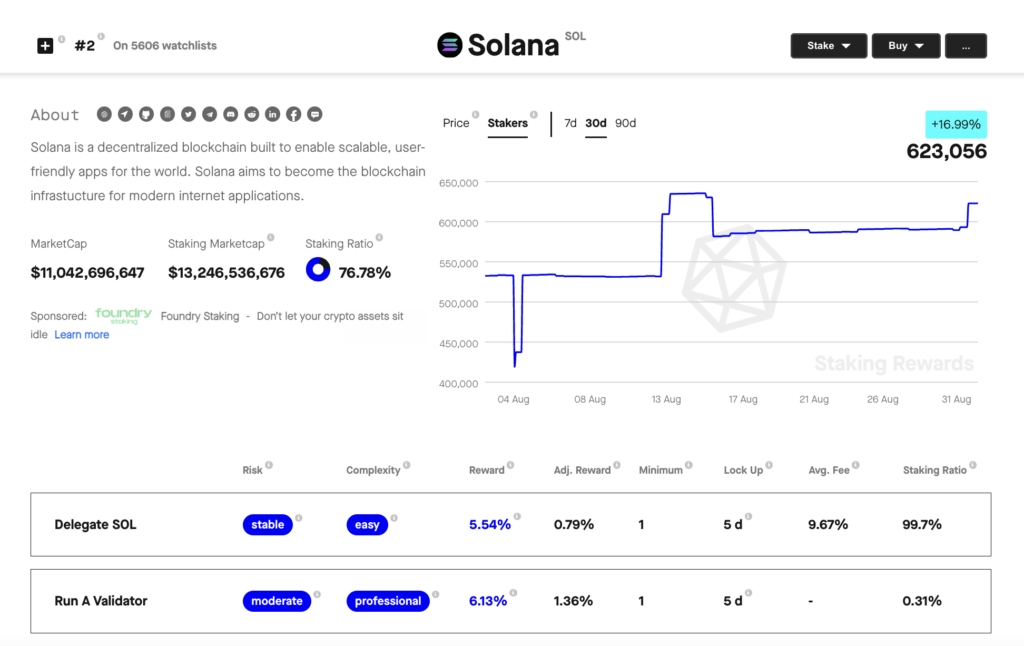How does crypto staking work?

What is staking crypto?
If your crypto rose from the grave and started sucking on your other savings, you’d probably want to stake it through the heart somehow, but that’s not quite what crypto staking is about.
The strict definition of crypto staking is when you take your crypto and lock it away in the blockchain so that you can claim a stake of rewards generated for processing transactions.
How does pure crypto staking work?
The exact mechanism differs from coin to coin, but the concept is simple for pure staking: there’s a way to specify how many of your coins you want to lock into the blockchain to get rewards.
What rewards exactly? Again, it differs from coin to coin, but it would normally be a share of newly minted coins, and sometimes a say in how the coin is run. In the long run, you would measure these rewards the same way you measure the return from any investment: by looking at its APY (Annual Percentage Yield).
There is a responsibility attached, though, you actually have to be running the correct software and leaving it online to process transactions. You don’t have to run every transaction, the blockchain chooses different stakeholders for every block, depending on how many coins they stake and a touch of randomness. This is how people who deposit more coins get more rewards.
What is proof of stake?
“Pure” crypto staking (directly into the blockchain) only works on coins that run a Proof-of-Stake consensus mechanism.
That is, the blockchain uses the processing power of existing coin holders to keep itself going and process transactions.
Proof-of-work coins use a competition model where computers compete to solve brute-force mathematical problems for rewards.
This is called mining, and the mining process doesn’t require you to hold any coins, so there’s no staking process. Bitcoin is the most famous example of this.
Popular Crypto Staking Coins
Ethereum (ETH)
The most popular coin to stake is the second biggest cryptocurrency: Ethereum. But while Ethereum staking has been going on, it’s not quite yet been built into the main blockchain which for the moment is still proof-of-work but into what’s called the “Beacon Blockchain” – an almost-but-not-quite-testnet.
Ethereum is heading into a “merge”, where the proof-of-stake and proof-of-work blockchains are combined, which is technically so complex you probably shouldn’t even think about it.
Because the DeFi sector always wants to have its cake and eat it too (and because Ethereum has no un-staking mechanism yet), another token exists: “stETH” or “Staked ETH”, which is a tradable token representing untradeable Ethereum and which trades at a discount to regular ETH.
This seems like one of those ideas that’s pre-doomed, but time will tell.
EOS
A well-established Ethereum competitor which also delivers decentralised processing, the EOS token can also be staked.
However, it’s a troubled blockchain that wasn’t decentralised enough and which let one particular party have too much control. You can learn more here.
One to avoid, probably.
Solana (SOL)
While EOS is an oldie, Solana is a super-fast new kid on the block to compete with Ethereum. Its main claim to fame is that it uses proof-of-stake and a new concept called “proof-of-history” to have a 400-millisecond gap between adding new blocks (compare this to Ethereum’s 13 seconds). It would be impossible to have a proof-of-work blockchain this fast because no one would solve the puzzles fast enough!
Polkadot (DOT)
Polkadot is a blockchain designed to transfer assets and information between other blockchains.
Polkadot gives you two ways to stake: you can be a “validator” (processes transactions) or a “nominator” (keeps an eye on validators). There’s actual competition for both “slots”: you can only have 22,500 nominators, for example. If there’s more than that, you won’t be able to join in. The APY for Polkadot for the top 256 validators is astonishingly high, but there’s also a lot of competition.
One to watch, but technically demanding.
Cardano (ADA)
Sometimes you just can’t stake on a blockchain yourself: there are too many technical demands or requirements. In that scenario, you’d join a “stake pool”, so called because you pool your resources with others so that they can be used (usually by a third party) as a stake.
Cardano explicitly acknowledges stake pools and the “stake delegates” who contribute their funds, and much of its functioning depends on playing stake pools against each other.
This means that if you contribute to a stake pool, it’s not a set-it-or-forget-it thing (like you have with AQRU and ETH): if the stake pool you’re in gets over-saturated, it can result in lower rewards and APY.
Tezos (XTZ)
Tezos is another open-source smart contract platform comparable to Ethereum. Like Cardano, it acknowledges two levels of staking. But, because it’s apparently cute, it gives them different names. For Tezos, the process of validating transactions is known as “baking”, and thus “validators” are now “bakers”. Smaller holders can delegate their tokens to these bakers, presumably for a bit of dough. Or, perhaps, crumbs.
There are other proof-of-stake coins, but you should be very suspicious of ones offering more return than the above coins!
How to stake crypto in 5 steps
1. Choose a crypto or coin to stake
You’ve seen some of the options up there, but it’s your decision. How much can you afford to stake? Can you run a transaction processor? How much knowledge and vigilance is required once you’ve done it? Does the coin have a future? Is the lock-in period to your liking?
The best website for comparisons is this Staking Rewards, where you can see the current rewards, price history and more. You will find an almost list of candidates and options, so overwhelming you might just decide to join AQRU and invest in Maple USDC.
For instance, here’s what the Staking Rewards website has to say about Solana:

2. Learn the minimum staking requirements
The above website is quite good for finding out minimum staking requirements, but not all the data is there. All good staking coins have a lot of official information available of course, and you’ll need that website because…
3. Download the software wallet for the desired coin
… it’s in the coin’s interest to make it as easy as possible to stake, unstake and earn rewards, which means a wallet will double as a stake manager.
4. Figure out what hardware to use
If you’re going to be running actual validators, then you need to set one up. Most stakers, rather than using their personal PCs, would set up a Linux VPN at a virtual host, download the software and set it running. This means your transaction processing isn’t subject to disconnection. This is not an easy task though: setting the server up is not easy, hardening its security is also not easy, and you’ll get charged a monthly fee.
5. Begin staking
Press that button! Start that engine! Rev that revver!
6. Monitor that investment
You’d think that staking was “set-it-and-forget-it”, but that’s not always true (for instance, Cardano stake pools need watching).
Is Staking profitable?
Well, in terms of you always having more crypto than you started with as long as you follow the rules, then it’s always going to be profitable.
In terms of the fiat value of your crypto, well, it’s likely the coin you possess will change in value from day to day much more than the increase in your crypto from the yield. All you can do is to think medium-to-long-term and hope that the coin goes up in fiat value to cash out at a profit. That’s unless you believe fiat currencies are doomed and we’ll all be using crypto, in which case you don’t care about fiat value…
Staking the non-stakeable
Of course, there are companies that offer yield-bearing crypto accounts that look a little like staking, but you can do it on coins without proof-of-stake, and it’s generally easier and more convenient. AQRU is one of those companies, currently offering a 2% yield on ETH (ETH Maple, 90-day lock-in applies), and 7% on Maple USDC. Download our app for more details.